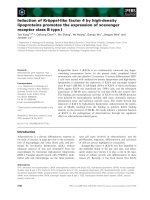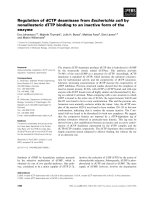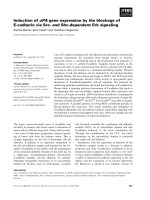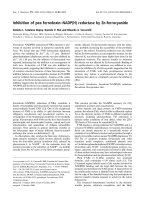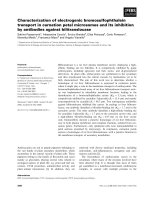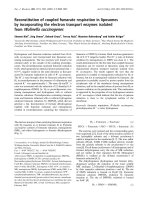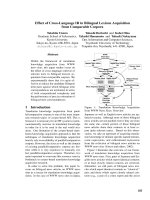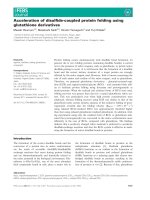Báo cáo khoa học: Induction of translationally controlled tumor protein (TCTP) by transcriptional and post-transcriptional mechanisms pot
Bạn đang xem bản rút gọn của tài liệu. Xem và tải ngay bản đầy đủ của tài liệu tại đây (419.42 KB, 9 trang )
Induction of translationally controlled tumor protein
(TCTP) by transcriptional and post-transcriptional
mechanisms
Irina Schmidt, Michael Fa
¨
hling, Benno Nafz, Angela Skalweit and Bernd-Joachim Thiele
Charite
´
, Universita
¨
tsmedizin Berlin, Institut fu
¨
r Vegetative Physiologie, Germany
Translationally controlled tumor protein (TCTP) is a
highly conserved 19 kDa GDP ⁄ GTP exchange factor
[1,2] that is involved in control of cell growth and pro-
liferation by regulating the activity of Rheb (Ras
homolog enriched in brain), a Ras superfamily GTPase
[3]. It has been identified in a broad spectrum of
eukaryotic organisms, from plants, yeasts, fungi, para-
sites, insects, fishes, and birds up to mammals, and is
involved in a wide range of cellular processes [4].
TCTP attracted interest mainly as an antiapoptotic
factor [5–7], for its role in tumorigenesis [8,9], and as a
tubulin-binding [10] or Ca
2+
-binding protein [11,12].
Moreover, it has other, extracellular, functions as a
histamine-releasing factor and cytokine [13,14].
TCTP synthesis is extensively regulated at the tran-
scriptional and post-transcriptional levels [4,15,16]. It is
ubiquitously expressed in all mammalian tissues ana-
lyzed so far, at a low rate in postmitotic tissues such as
Keywords
gene expression; post-transcriptional
control; TPT1 gene, transcription;
translationally controlled tumor protein
(TCTP)
Correspondence
B J. Thiele, Charite
´
, Universita
¨
tsmedizin
Berlin, Institut fu
¨
r Vegetative Physiologie,
Tucholskystr. 2, 10117 Berlin, Germany
Fax: +49 30 450 528972
Tel: +49 30 450 528184
E-mail:
(Received 14 June 2007, revised 23 August
2007, accepted 28 August 2007)
doi:10.1111/j.1742-4658.2007.06069.x
Expression of the human TPT1 gene coding for translationally controlled
tumor protein (TCTP) was investigated in Calu-6 and Cos-7 cells under the
influence of 4b-phorbol 12-myristate 13-acetate (PMA), forskolin, dioxin
and the heavy metals copper, nickel and cobalt. Transcriptional and
post-transcriptional aspects of the mechanism were analyzed by TCTP
mRNA ⁄ protein quantification, luciferase reporter gene assays depending
on TPT1 promoter sequences or TCTP mRNA 5¢⁄3¢-UTRs and investiga-
tion of the interaction of RNA-binding proteins with UTRs by UV-cross-
linking. PMA, forskolin, dioxin, cobalt and nickel induced TCTP
expression in 24 h in both cell lines about 2.2–3.2-fold at the mRNA level
and 1.6–2.2-fold at the protein level. The highest induction rate, 4.5–5.0-
fold at the mRNA level and 3.5–4.0-fold at the protein level, was observed
with copper. TPT1 promoter assays showed transcriptional activation by
PMA, forskolin and dioxin (2.0–3.1-fold) and a 7.0–8.0-fold increase by
copper, whereas cobalt and nickel had no effect. Deletion analysis revealed
that copper-dependent transcriptional control was transmitted by a metal-
responsive element residing in the TPT1 promoter. Post-transcriptional
activation of TCTP expression was associated with the action of dioxin,
nickel, cobalt (1.8–2.3-fold) and copper (2.5–3.0-fold), whereas stimulation
of TCTP synthesis by copper was mediated by the TCTP mRNA 3¢-UTR
(3.2-fold) but not by the 5¢-UTR (0.5-fold). mRNA stabilization was found
to mediate these effects of cobalt and nickel. Post-transcriptional regulation
was associated with qualitative and quantitative changes in the binding of
specific RNA-binding proteins to UTRs.
Abbreviations
ARE, AU-rich element; CREB, cAMP-responsive element-binding protein; HIF, hypoxia inducible factor; MRE, metal-responsive element;
PMA, 4b-phorbol 12-myristate 13-acetate; RNA-BP, RNA-binding protein; TCTP, translationally controlled tumor protein; TPT1, gene coding
for human TCTP.
5416 FEBS Journal 274 (2007) 5416–5424 ª 2007 The Authors Journal compilation ª 2007 FEBS
brain, but at high levels in tissues undergoing active cell
division and in tumor cells [8,9,17]. A wide variety of
chemicals are able to induce TCTP synthesis, including
substances such as phorbol esters and lipopolysaccha-
rides [18], cytotoxic drugs [19], Ca
2+
[11], heavy metals
[20], and dioxins [21]. However, less is known about
the mechanistic background of their action. A first
analysis of transcriptional control of the TPT1 gene
revealed that phorbol esters and forskolin stimulate
TCTP synthesis by cAMP-responsive element-binding
protein (CREB) transcription factors via cAMP signal-
ing [22]. How other stimulators, including divalent
heavy metals and dioxins, act is unknown.
In this study we investigated the capability of poten-
tial TCTP synthesis-stimulating substances with differ-
ent chemical structures to induce TPT1 gene expression
at the transcriptional or post-transcriptional level in
culture cells. For this purpose, we employed TCTP
mRNA and protein quantification as well as luciferase
reporter gene expression, using constructs in which the
luciferase gene is under control of TPT1 promoter
sequences or TCTP mRNA 5¢⁄3¢-UTRs and by study-
ing RNA–protein interactions.
Results
We investigated TCTP expression in human Calu-6
cells, a lung carcinoma cell line, and in monkey Cos-7
cells, a kidney fibroblast cell line, under the influence
of 4b-phorbol 12-myristate 13-acetate (PMA), forskolin
and dioxin, or the heavy metals nickel, cobalt and
copper. To discriminate between transcriptional and
post-transcriptional actions, we performed cell transfec-
tion experiments and luciferase reporter gene assays in
two different ways. To analyze the effect of TCTP
induction on transcription, the main promoter of
the human TPT1 gene () 312 ⁄ ) 1) [22] was cloned
upstream of the promoterless luciferase gene and
assayed. For characterization of mRNA-related regula-
tive capacity, 5¢- and 3 ¢-UTRs of TCTP mRNA were
cloned upstream and downstream of the luciferase gene
containing a constitutive promoter. Figures 1 and 2
show TCTP mRNA and protein quantification data,
demonstrating the way in which TCTP expression
responded to the six selected substances. It is evi-
dent that PMA, forskolin, dioxin, cobalt and nickel
were able to induce TCTP in both cell lines at the
mRNA and protein levels by 2.2–3.2-fold (mRNA) and
1.6–2.2-fold (protein) in 24 h. The highest induction
rate was observed with copper, i.e. 4.5–5.0-fold
(mRNA) and 3.5–4.0-fold (protein).
Figure 3 depicts TPT1 promoter ⁄ luciferase reporter
gene assays. It is obvious that the transcriptional activ-
ity of the TPT1 promoter has only a partial similarity
to TCTP mRNA and TCTP protein expression. In
both cell lines, PMA, forskolin and dioxin stimulated
transcription about 2.0–3.1-fold. Only copper stimu-
lated the luciferase reporter gene at a high rate
between 7.0-fold and 8.0-fold, whereas nickel and
cobalt did not stimulate transcription; instead, they
reduced luciferase expression slightly. In Fig. 4, the
influence of potential TCTP stimulators on luciferase
expression is shown, with the luciferase gene put under
control of TCTP mRNA UTRs. A moderate post-
transcriptional stimulatory effect was seen with dioxin,
nickel and cobalt (1.8–2.3-fold), and again the highest
rate was seen with copper (2.5–3.0-fold).
The finding that copper ions are able to stimulate
TPT1 gene transcription very effectively prompted us
to investigate the mechanistic background in more
detail. A comparative theoretical analysis of the
human TPT1 promoter led to the discovery of a puta-
tive metal-responsive element (MRE) in position
) 81 ⁄ ) 68 (see Discussion). A variant of the TPT1 pro-
moter, in which the MRE was deleted, was used in the
TCTP mRNA/β-Actin mRNA
A
B
Fig. 1. Influence of various substances on TCTP expression at the
mRNA level. Human lung tumor Calu-6 or monkey kidney tumor
Cos-7 cells were incubated in the absence or presence of PMA,
forskolin (Fors), dioxin (Diox), NiCl
2
(Ni), CoCl
2
(Co) or CuCl
2
(Cu) for
24 h. Total RNA was extracted, and TCTP mRNA was analyzed by
northern blotting and quantified by scanning using
SCION IMAGE soft-
ware. TCTP mRNA levels were normalized to the internal control,
b-actin mRNA. (A) Representative northern blot including loading
control (18S and 28S rRNA stained by ethidium bromide). (B) Statis-
tical analysis of three independent experiments. For quantification,
the sum of both TCTP mRNA signals (0.8 and 1.2 kb, differing in
the length of the 3¢-UTR [22]) was used.
I. Schmidt et al. TCTP induction
FEBS Journal 274 (2007) 5416–5424 ª 2007 The Authors Journal compilation ª 2007 FEBS 5417
same type of luciferase reporter gene experiment as
described in Fig. 3. The deletion of the putative MRE
resulted in a nearly complete loss of the ability of the
TPT1 promoter to respond to copper ions. The resid-
ual luciferase activity dropped to about 10% as com-
pared to the construct with an intact MRE (Fig. 5A).
As demonstrated in Fig. 4, UTRs of mRNA are
targets mediating post-transcriptional regulation of
TCTP expression. To discriminate between 5¢- and
3¢-UTR-mediated actions, we created luciferase con-
structs that were separately under control of the
TCTP 5¢-or3¢ -UTR and performed copper-depen-
dent transfection ⁄ reporter gene assays (Fig. 5B). The
results show that the post-transcriptional copper
stimulation of TCTP expression was associated exclu-
sively with the 3¢-UTR (3.2-fold stimulation). In con-
trast, the 5¢-UTR had an inhibitory effect of about
50%, and the 5¢⁄3¢-UTR combination resulted in
intermediate values (about 2.5-fold stimulation).
Nickel and cobalt seem to stimulate TCTP expres-
sion, not by transcriptional activation but solely by
mRNA-targeted post-transcriptional processes. The
results shown in Fig. 1 demonstrate that the action of
cobalt and nickel led to an increase in mRNA concen-
tration, but not to activation of the promoter (Fig. 3).
This could imply an influence on mRNA stability. To
clarify this, we inhibited transcription with actinomy-
cin D and followed the kinetics of TCTP mRNA
decay (Fig. 6). Interestingly, inhibition of transcription
by actinomycin D treatment did not accelerate mRNA
decay as expected; instead, it slowed down this process
slightly. Nickel and cobalt treatment delayed TCTP
mRNA decay further, and clearly increased mRNA
stability. To test to what extent RNA-binding proteins
(RNA-BPs) are involved in post-transcriptional control
of TCTP synthesis, electromobility shift assays and
UV-crosslinking assays were performed. For this pur-
pose,
32
P-labeled in vitro transcripts of the 5¢-UTR and
3¢-UTR of the main TCTP mRNA were incubated
with cytosolic extracts (S10) of Calu-6 cells, which
were grown with a selection of inducing agents (PMA,
dioxin, cobalt and nickel) or without effector as a con-
trol. The 5¢- and 3¢-UTR gave specific signals of
TCTP/β-Actin
A
B
Fig. 2. Influence of various substances on TCTP expression at the
protein level. Cells were treated with TCTP-inducing substances as
described in Fig. 1, cytoplasmic protein extracts were separated on
SDS gels, and TCTP was visualized by western blotting. Blots were
quantified by scanning, as described in Fig. 1. TCTP levels were
normalized to internal b-actin using an antibody to b-actin. (A) Rep-
resentative western blot including b-actin control. (B) Statistical
analysis of three independent experiments.
Fig. 3. Effect of TCTP-inducing substances on TPT1 promoter activ-
ity. Three hundred and twelve nucleotides of the human TPT1 pro-
moter () 312 ⁄ ) 1) were cloned 5¢- to the promoterless firefly
luciferase gene in the vector pGLbasic. Plasmids were transfected
into Calu-6 and Cos-7 cells in the presence or absence of TCTP-
inducing substances. For normalization of transfection efficiency,
cells were cotransfected with Renilla luciferase. Luciferase assays
were performed as described in Experimental procedures (n ¼ 6).
Fig. 4. Effect of TCTP mRNA 5¢- and 3¢-UTR on luciferase reporter
gene expression in the presence of TCTP-inducing substances.The
complete 5¢- and 3¢-UTR of human TCTP mRNA were cloned
upstream and downstream of the luciferase coding sequence into
the pGL3promoter vector containing a constitutive SV40 promoter,
thereby replacing luciferase UTRs. Cells were transfected in the
presence or absence of TCTP-inducing substances, and luciferase
activity was assayed as described in Fig. 3 (n ¼ 6).
TCTP induction I. Schmidt et al.
5418 FEBS Journal 274 (2007) 5416–5424 ª 2007 The Authors Journal compilation ª 2007 FEBS
RNA–protein complexes with the electromobility shift
assay; however, significant differences in the electro-
phoretic migration behavior of the complexes were
observed neither with control nor with effector-treated
cell extracts (not shown). To detect more subtle differ-
ences in the composition of RNA–protein complexes,
we performed UV-crosslinking experiments (Fig. 7).
The results can be summarized as follows: (a) the pat-
terns of protein binding to the 5¢-UTR or 3¢-UTR dif-
fer significantly, although some proteins seem to bind
to both; (b) the pattern of 5¢-UTR and 3¢-UTR protein
binding of PMA-treated cell extracts does not differ as
compared to the control; (c) dioxin-, nickel- and
cobalt-treated extracts show qualitative (appearance of
new bands and suppression of control bands) and
quantitative (signal intensity) differences in binding
properties at the 5¢-UTR as well at the 3¢-UTR as
compared to controls.
Discussion
TCTP is a ubiquitous protein with a basic role in
G-protein signaling. It is effectively induced under a
wide variety of growth and stress conditions, and by
chemical substances with quite different structures.
Recently, we demonstrated the transcriptional activa-
tion of the human TPT1 promoter by phorbol ester
and forskolin in T24 cells, a bladder carcinoma cell
line, via cAMP-responsive element–CREB interaction
[22]. As shown in the present study, the TPT1 pro-
moter responded in a similar way in Calu-6 and Cos-7
cells. Therefore, we investigated whether TCTP expres-
sion could also be stimulated by post-transcriptional
events. Reporter gene assays demonstrated that the
UTRs of TCTP mRNA were able to mediate a stimula-
tory effect on luciferase expression under the influence
of dioxin, copper, nickel and cobalt. On the other
hand, PMA and forskolin seem to act by a pure tran-
scriptional mechanism, as suggested in our earlier work
[22]. As demonstrated by actinomycin D inhibition
experiments (Fig. 6), nickel and cobalt are able to
stabilize TCTP mRNA, thereby improving TCTP
synthesis. UTRs mediate their controlling properties
predominantly by interaction with regulative RNA-
BPs. The action of nickel and cobalt was primarily
discussed in the context of their capability to interact
with transcription factor hypoxia inducible factor
(HIF), thereby simulating hypoxic conditions [23–25].
Our experiments demonstrate that cobalt and nickel do
not interfere with TPT1 transcription. Moreover, no
HIF-responsive element can be detected in the TPT1
promoter. On the other hand, as shown with erythro-
poietin or tyrosine hydroxylase, improved expression
by hypoxia is partially controlled by UTRs of the
appropriate mRNAs in interaction with RNA-BPs
[26,27]. In the case of TCTP mRNA, this view is sup-
ported by our RNA–protein interaction studies
(Fig. 7). Nickel as well as cobalt treatment changes the
pattern of protein binding to the 5¢-UTR and 3¢-UTR.
This indicates that RNA-BPs may contribute to
post-transcriptional control of TCTP mRNA stability.
Interestingly, the crosslinking patterns of cobalt- and
A
B
Fig. 5. Transcriptional and post-transcriptional control of TCTP
expression by copper. (A) Copper-dependent luciferase expression
in Cos-7 cells after transfection with luciferase vector pGL3 pro-
moter modified with the TPT1 promoter. The SV40 promoter of
pGL3 has been replaced by the TPT1 promoter () 312 ⁄ )1 ) con-
taining an MRE at position ) 81 ⁄ ) 68, or using a construct in which
the MRE was deleted (– MRE). Copper-related reporter gene
expression was dependent on the presence of the MRE (+ MRE)
in the TPT1 promoter. (B) Copper-dependent luciferase expression
after transfection with vector pGL3 promoter modified with TCTP
UTRs. The Luc UTRs have been replaced by TCTP mRNA 5¢- and
3¢-UTRs (5¢⁄3¢), by TCTP mRNA 5¢-UTR (5¢), or by TCTP mRNA 3¢-
UTR. The TCTP 3¢-UTR but not the 5¢-UTR stimulated reporter gene
expression in the presence of copper. Experiments were repeated
three times.
I. Schmidt et al. TCTP induction
FEBS Journal 274 (2007) 5416–5424 ª 2007 The Authors Journal compilation ª 2007 FEBS 5419
nickel-treated cell extracts are not identical. This sug-
gests that mechanistic details may differ between nickel
and cobalt action. However, the nature of putative
cis-elements in TCTP mRNA and trans-acting factors,
as well as the role of nickel and cobalt ions, have yet to
be analyzed experimentally. So far, our experiments
demonstrate (Fig. 6) that cobalt and nickel act via inhi-
bition of TCTP mRNA decay, and that this is associ-
ated with differences in the interaction of cytosolic
proteins with the TCTP mRNA 5¢-UTR and 3¢-UTR.
Dioxin induced TCTP synthesis in a mixed tran-
scriptional ⁄ post-transcriptional mode. The high toxic-
ity of dioxins is related to their action as ‘endocrine
disrupters’. The endocrine disrupter function includes
changes of expression of dioxin target genes, one of
which is the gene encoding TCTP [21]. Dioxins bind to
the aryl hydrocarbon receptor, which then dimerizes
with the aryl hydrocarbon receptor nuclear transloca-
tor, to interact with a xenobiotic response element
motif in the DNA. Oikawa et al. found by computer
search a xenobiotic response element motif 5 kb
upstream of the mouse and human TPT1 transcription
initiation site [21], which could explain the observed
transcriptional activation. The TCTP mRNA UTRs,
on the other hand, seem to contain additional
sequences that could be involved in a xenobiotic
response. The crosslinking pattern obtained with
dioxin-treated cell extracts differs significantly from
controls and from experiments with heavy metal-trea-
ted cells (Fig. 7), suggesting the participation of indi-
vidual RNA-BPs in this response. Potential candidate
proteins and mechanistic details have yet to be investi-
gated.
The TCTP-inducing capability of copper was known
from experiments with earthworms inhabiting copper-
contaminated soils [20]. No data, however, exist from
mammals or from mammalian cells in culture. In Calu-
6 and Cos-7 cells, copper turned out to be a potent
inducing agent, comparable to the situation in earth-
worms. From the mechanistic point of view, it is of
interest that the action of copper involves both a tran-
scriptional and a post-transcriptional effect, although
the strong promoter action exceeds the influence of the
UTRs by a factor of 3 in reporter gene assays. Proto-
types of metal-inducible genes, which play an important
role in metal ion homeostasis and which are effectively
induced by transitional metals such as copper, cadmium
or zinc, are the metallothionein genes. Metal-inducible
metallothionein transcription is regulated primarily
through the interaction between MREs and metal tran-
scription factor-1 [28,29]. The MRE consensus sequence
is described as a core motif with the sequence
TGC(G ⁄ A)CNC flanked by a short GC-rich domain
[30]. This sequence shows a high degree of homology
A
B
TCTPmRNA/rRNA
rel.units
Fig. 6. Control of TCTP mRNA stability by cobalt and nickel. Cos-7 cells were cultivated for up to 36 h in the presence of actinomycin D with
or without 300 l
M NiCl
2
(Ni) or 300 lM CoCl
2
(Co). Total RNA was extracted at each time point, and TCTP mRNA was analyzed by northern
blotting and quantified by scanning using
SCION IMAGE software. TCTP mRNA levels were normalized to internal 18S and 28S rRNA stained
with ethidium bromide, which were also quantified by scanning. (A) Representative northern blot and rRNA staining. (B) Statistical analysis
of three independent experiments. For mRNA quantification, the sum of both TCTP transcripts of 0.8 and 1.2 kb [22] was used. Inhibition of
transcription by actinomycin D increased the TCTP mRNA half-life slightly, but nickel and cobalt gave an additional and significant increase in
mRNA stability.
TCTP induction I. Schmidt et al.
5420 FEBS Journal 274 (2007) 5416–5424 ª 2007 The Authors Journal compilation ª 2007 FEBS
with a sequence in the TPT1 promoter (TGCGtCGCT-
TCCGG, ) 81 ⁄ ) 68), which is highly conserved in
mammalian TPT1 genes [16,22]. It mismatches the con-
sensus core motif in only one nucleotide (printed in
lower case), and could be addressed as an MRE-like
sequence, as it functions in copper induction of prion
protein expression [31]. Of particular interest is the find-
ing that copper stimulates TCTP expression at the post-
transcriptional level. In earlier work, post-transcrip-
tional events were postulated in the context of induc-
tion of human metallothionein genes by copper,
although no mechanistic details were published [32]. In
this study, we have shown that the post-transcriptional
copper response at the mRNA level is associated with
the 3¢-UTR. With regard to the mRNA sequence, it has
been known since the first cloning of human TCTP
mRNA that three AU-rich elements (AREs) of the
AUUUA type reside in the TCTP 3¢-UTR [33]. In
general, AREs are associated with mRNA stabiliza-
tion ⁄ destabilization, depending on ARE type and on
the interaction with different ARE-binding proteins
such as AUF1 or HuR [34]. At present, we can only
speculate that these AREs could be targets for TCTP
mRNA stabilization, a process possibly triggered by
copper ions. The molecular details of the nature of the
cis-elements and trans-acting factors involved (RNA-
BPs or micro RNAs) and, in particular, the signaling
pathway related to the interaction with copper ions
remain to be investigated.
Recently, the renal transcriptional response of TCTP
to another heavy metal, uranium, was investigated.
Uranyl ions induced TCTP at the mRNA level about
two-fold and at the protein level at least five-fold [35].
This suggests a transcriptional as well as a post-tran-
scriptional mechanism in the stress response to ura-
nium, as for copper.
Experimental procedures
Cell culture and RNA ⁄ protein isolation
Human fetal lung carcinoma Calu-6 cells were maintained
in MEM ⁄ Earle’s (Biochrom AG, Berlin, Germany) con-
taining 10% heat-inactivated fetal bovine serum,
1 · MEM nonessential amino acids, 1 · MEM sodium
pyruvate, 0.065% sodium hydrogen carbonate, 200 l m l-
glutamine, 100 UÆmL
)1
penicillin, and 10 lgÆmL
)1
strepto-
mycin. Monkey kidney fibroblast Cos-7 cells were main-
tained in DMEM (high glucose; PAA Laboratories
GmbH, Co
¨
lbe, Germany) supplemented with 10% heat-
inactivated fetal bovine serum, 200 lm l-glutamine,
100 UÆmL
)1
penicillin, 10 lgÆmL
)1
streptomycin, and
10 mm Hepes buffer. The cells were cultured in a 5% CO
2
atmosphere at 37 °C.
Stimulation experiments were carried out with forskolin,
10 lm final concentration (Sigma, Taufkirchen, Germany;
stock solution 10 mm in dimethylsulfoxide), PMA, 100 nm
final concentration (Sigma, stock solution 100 lm in dim-
ethylsulfoxide), dioxin, 100 nm final concentration
(50 lgÆmL
)1
stock solution of 2,3,7,8-tetrachlorodibenzo-p-
dioxin in dimethylsulfoxide; LGC Promochem, Wesel,
Germany), 30 lm CuCl
2
(VWR International, Dresden,
Germany), 300 lm CoCl
2
(Sigma) or 300 lm NiCl
2
(Sigma), for the times indicated. For inhibition of transcrip-
tion, actinomycin D (MoBiTech, Goettingen, Germany)
was used at a concentration of 10 lgÆmL
)1
.
For RNA and protein isolation, cells were washed with
ice-cold NaCl ⁄ P
i
. RNA was prepared using RNA-Bee
(Biozol Diagnostica Vertrieb GmbH, Eching, Germany), in
accordance with the manufacturer’s protocol. Protein
extracts (10 000 g supernatants, S10, Sigma 3K15 centrifuge
with 12154-H rotor, Sigma Laborzentrifugen GmbH,
Fig. 7. Interaction of RNA-BPs with TCTP mRNA 5¢- and 3¢-UTR
analyzed by UV-crosslinking. The complete 5¢-UTR (134 nucleotides)
and 3¢-UTR1 (257 nucleotides) of the main TCTP mRNA were tran-
scribed in vitro in the presence of [
32
P]UTP and incubated with
cytoplasmic cell extracts (S10) of Calu-6 cells (control) or cells, in
which TCTP was induced for 24 h by PMA, dioxin, NiCl
2
, or CoCl
2
.
After UV-crosslinking and RNase digestion, transfer-labeled RNA-
BPs were analyzed by SDS ⁄ PAGE and autoradiography. As molecu-
lar weight markers, the
14
C-labeled protein marker mixture of
Amersham was run in the same gel.
I. Schmidt et al. TCTP induction
FEBS Journal 274 (2007) 5416–5424 ª 2007 The Authors Journal compilation ª 2007 FEBS 5421
Osterode, Germany) were isolated using lysis buffer (10 mm
Tris, pH 7.5, 140 mm NaCl, 1 mm EDTA, 25% glycerol,
0.1% SDS, 0.5% Nonidet P-40, 1 mm dithiothreitol and
complete protease inhibitor mix; Roche Diagnostics, Mann-
heim, Germany).
Cell transfection and luciferase reporter gene
assays
Calu-6 and Cos-7 cells were cultured in 96-well plates
(lClear Platte 96K; Greiner BIO-ONE GmbH, Fricken-
hausen, Germany) and cotransfected with the firefly lucif-
erase pGL3 promoter vector (Promega, Mannheim,
Germany), or with constructs containing TPT1 promoter
or TCTP mRNA UTR sequences and the Renilla lucifer-
ase phRL-TK vector (ratio 1 : 1.5 or 1 : 2), using the
FuGENE 6 Transfection Reagent (Roche Diagnostics)
according to the manufacturer’s protocol. Transfection
was carried out in the presence or absence of TCTP-stim-
ulating substances (see ‘Cell culture and RNA ⁄ protein iso-
lation’). After 6 h, the transfection medium was removed,
and measurements were started after addition of fresh
medium. The luciferase activity was detected using a lumi-
nometer (Luminoscan RS, Thermo Electron GmbH,
Dreieich, Germany) programmed with individual software
(luminoscan rii; R. Mrowka, Institute of Physiology,
Charite
´
, Berlin). The transfection with the Renilla lucifer-
ase served as control.
Molecular cloning procedures
For analysis of the TCTP promoter in luciferase reporter
gene assays, the promoterless luciferase vector pGL3basic
was used. Nucleotides ) 1 ⁄ ) 312 of the human TPT1 pro-
moter were amplified from a genomic clone [22] and
inserted into the multiple cloning region (KpnI ⁄ NphEI site)
of pGL3basic.
For analysis of TCTP UTRs, the luciferase vector
pGL3 promoter (Promega; constitutive SV40 promoter)
was modified. Therefore, the vector-specific 5¢- and
3¢-UTRs of luciferase mRNA were replaced by human
TCTP mRNA UTRs. The UTRs (5¢-UTR, 134 nucleo-
tides, and 3¢-UTR, 257 nucleotides) [16] were amplified by
PCR, and restriction sites were added by primer extension.
The 5¢-UTR of TCTP mRNA was cloned using the
pGL3p vector-specific HindIII and NcoI restriction sites,
and the 3¢-UTR using the XbaI and BamHI restriction
sites. The quality of processed vectors was confirmed by
sequencing. The resulting vector constructs expressed a
constitutively transcribed luciferase transcript with or with-
out specific TCTP UTRs.
The ) 73 ⁄ ) 80 nucleotide-deleted human TPT1 promoter
) 1 ⁄ ) 312 construct in pGL3p was obtained by PCR for
assessment of the influence of the MRE region on luciferase
expression under stress.
Northern and western blot analysis
Total cellular RNA (15 lg) was separated by electrophore-
sis on 1% agarose gels containing formaldehyde. The
RNA was capillary-transferred to positively charged nylon
membranes (Roche Diagnostics), visualized by ethidium
bromide staining to document relative levels of 18S ⁄ 28S
rRNA, and hybridized to digoxygenin-labeled TCTP anti-
sense transcripts. The detection was performed using the
digoxygenin RNA Labeling Kit (Roche Diagnostics)
according to the manufacturer’s protocol. mRNA levels
were normalized to 18S and 28S rRNA.
Protein extracts (20 lg per sample) were separated by
SDS ⁄ PAGE. After electrophoresis, proteins were trans-
ferred to Hybond-P membranes (Amersham Pharmacia
Biotech, Freiburg, Germany) using a Bio-Rad (Munich,
Germany) Mini Trans-Blot transfer cell. The membranes
were blocked for 1 h with 5% Blot-Quick Blocker (Chem-
icon, Schwelbach, Germany). After the blocking step, the
membranes were incubated in 1% blocking solution
containing a primary antibody to TCTP (MoBiTec, Goet-
tingen, Germany) at room temperature for 1 h. The mem-
branes were washed three times with NaCl ⁄ Tris containing
Tween-20 and were then incubated with a secondary
antibody (donkey anti-rabbit; Santa Cruz, Heidelberg,
Germany) for 1 h. After additional washing steps, bands
were detected using the ECL plus Western Blotting Detec-
tion System (Amersham Pharmacia Biotech). Membranes
were stripped for 5 min with distilled water, for 3–5 min
with 0.2 m NaOH, and for 5 min with distilled water, and
reprobed with anti-b-actin (Chemicon) or anti-(glyceralde-
hyde-3-phosphate dehydrogenase) (Acris Antibodies
GmbH, Hiddenhausen, Germany) antibodies, with a sec-
ondary antibody (anti-mouse; Santa Cruz) to detect rela-
tive b-actin and glyceraldehyde-3-phosphate dehydrogenase
levels as loading control.
UV-crosslinking
UV-crosslinking experiments were performed as described
previously [36]. Briefly, the following protocol was used.
In vitro transcripts representing the 5¢-or3¢-UTR of TCTP
mRNA (cloned in TOPO II vector, transcription with T7
or SP6 polymerase) were radioactively labeled using
[
32
P]UTP[aP] (800 CiÆmmol
)1
; MP Biomedicals GmbH,
Heidelberg, Germany). For UV-crosslinking experiments 1–
2ng of [
32
P]UTP[aP]-labeled in vitro transcripts represent-
ing 200 000 c.p.m. were incubated with 40–60 lg of cyto-
solic protein extract for 15 min in a total volume of 10 lL
at room temperature in 10 mm Hepes, pH 7.2, 3 mm
MgCl
2
, 5% glycerol, 1 mm dithiothreitol, 150 mm KCl, and
2UÆlL
)1
RNaseOUT (Invitrogen, Karlsruhe, Germany), in
the presence of rabbit rRNA (0.5 lgÆlL
)1
). Then, the sam-
ples were exposed to UV light for 15 min on ice (255 nm,
1.6 J; UV-Stratalinker, Stratagene, Heidelberg, Germany),
TCTP induction I. Schmidt et al.
5422 FEBS Journal 274 (2007) 5416–5424 ª 2007 The Authors Journal compilation ª 2007 FEBS
treated with RNase A (30 lgÆmL
)1
final concentration) and
RNase T1 (750 UÆmL
)1
final concentration) for 15 min at
37 °C, and subjected to 12% SDS ⁄ PAGE and autoradiog-
raphy.
Statistical analysis
Data are shown as means ± SD.
Acknowledgements
The authors acknowledge financial support by the
Deutsche Forschungsgemeinschaft to B J. Thiele
(Th 459 ⁄ 3-3 and Th 459 ⁄ 5–1).
References
1 Thaw P, Baxter NJ, Hounslow AM, Price C, Waltho JP
& Craven CJ (2001) Structure of TCTP reveals unex-
pected relationship with guanine nucleotide-free chaper-
ones. Nat Struct Biol 8, 701–704.
2 Cans C, Passer BJ, Shalak V, Nancy-Portebois V, Cri-
ble V, Amzallag N, Allanic D, Tufino R, Argentini M,
Moras D et al. (2003) Translationally controlled tumor
protein acts as a guanine nucleotide dissociation inhibi-
tor on the translation elongation factor eEF1A. Proc
Natl Acad Sci USA 100, 13892–13897.
3 Hsu YC, Chern JJ, Cai Y, Liu M & Choi KW (2007)
Drosophila TCTP is essential for growth and prolifera-
tion through regulation of dRheb GTPase. Nature 445,
785–788.
4 Bommer UA & Thiele BJ (2004) The translationally
controlled tumour protein (TCTP). Int J Biochem Cell
Biol 36, 379–385.
5 Li F, Zhang D & Fujise K (2001) Characterization of
fortilin, a novel antiapoptotic protein. J Biol Chem 276,
47542–47549.
6 Liu H, Peng HW, Cheng YS, Yuan HS & Yang-Yen HF
(2005) Stabilization and enhancement of the antiapop-
totic activity of Mcl-1 by TCTP. Mol Cell Biol 25, 3117–
3126.
7 Rinnerthaler M, Jarolim S, Heeren G, Palle E, Perju S,
Klinger H, Bogengruber E, Madeo F, Braun RJ, Brei-
tenbach-Koller L et al. (2006) MMI1 (YKLO56c,
TMA19), the yeast orthologue of the translationally
controlled tumor protein (TCTP) has apoptotic func-
tions and interacts with both microtubules and mito-
chondria. Biochim Biophys Acta 1757, 631–638.
8 Chung S, Kim M, Choi W, Chung J & Lee K (2000)
Expression of translationally controlled tumor protein
mRNA in human colon cancer. Cancer Lett 156, 185–
190.
9 Tuynder M, Susini L, Prieur S, Besse S, Fiucci G,
Amson R & Telerman A (2003) Biological models and
genes of tumor reversion: cellular programming through
tpt1 ⁄ TCTP and SIAH-1. Proc Natl Acad Sci USA 99,
14976–14981.
10 Gachet Y, Tournier S, Lee M, Lazaris-Karatzas A, Poul-
ton T, Bommer UA. The growth-related translationally
controlled protein P23 has properties of a tubulin bind-
ing protein and associates transiently with microtubules
during the cell cycle. J Cell Sci 112, 1257–1271.
11 Xu A, Bellamy AR & Taylor JA (1999) Expression of
translationally controlled tumor protein is regulated by
calcium at both the transcriptional and post-transcrip-
tional level. Biochem J 342, 683–689.
12 Arcuri F, Papa S, Carducci A, Romagnoli R,
Liberatori S, Riparbelli MG, Sanchez JC, Tosi P &
del Vecchio MT (2004) Translationally controlled
tumor protein (TCTP) in the human prostate and
prostate cancer cells: expression, distribution, and
calcium binding activity. Prostate 60, 130–140.
13 MacDonald SM, Rafnar T, Langdon J & Lichtenstein
LM (1995) Molecular identification of an IgE-dependent
histamine-releasing factor. Science 269, 688–690.
14 Bheeka-Escura R, MacGlashan DW, Langdon JM &
MacDonald SM (2000) Human recombinant histamine-
releasing factor activates human eosinophils and the
eosinophilic cell line. Blood 96, 2191–2198.
15 Bommer UA, Borovjagin AV, Greagg MA, Jeffrey IW,
Russell P, Laing KG, Lee M & Clemens MJ (2002) The
mRNA of the translationally controlled tumor protein
P23 ⁄ TCTP is a highly structured RNA, which activates
the dsRNA-dependent protein kinase PKR. RNA
8,
478–496.
16 Thiele H, Berger M, Lenzner C, Ku
¨
hn H & Thiele BJ
(1998) The promoter structure and complete sequence
of the rabbit gene coding for the translationally con-
trolled tumor protein (TCTP) P23. Eur J Biochem 257,
62–68.
17 Thiele H, Berger M & Thiele BJ (2000) Expression of
the gene and processed pseudogenes coding for the
human and rabbit translationally controlled tumour
protein (TCTP). Eur J Biochem 267, 5473–5481.
18 Walsh BJ, Gooley AA, Williams KL & Breit SN
(1995) Identification of macrophage activation
association proteins by two-dimensional gel electro-
phoresis and microsequencing. J Leukocyte Biol 57,
507–512.
19 Sinha P, Kohl S, Hu
¨
tter G, Kern M, Ko
¨
ttgen E,
Dietel M, Lage H, Schno
¨
lzer M & Schadendorf D
(2000) Identification of novel proteins associated with
the development of chemoresistance in malignant
melanoma using two-dimensional electrophoresis.
Electrophoresis 21, 3048–3057.
20 Sturzenbaum SR, Kille P & Morgan AJ (1998) Identifi-
cation of heavy metal induced changes in the expression
patterns of the translationally controlled tumour protein
I. Schmidt et al. TCTP induction
FEBS Journal 274 (2007) 5416–5424 ª 2007 The Authors Journal compilation ª 2007 FEBS 5423
(TCTP) in the earthworm Lumbricus rubellus. Biochim
Biophys Acta 1398, 294–304.
21 Oikawa K, Ohbayashi T, Mimura J, Fujii-Kuriyama Y,
Teshima S, Rokutan K, Mukai K & Kuroda M (2001)
Dioxin stimulates synthesis and secretion of IgE-depen-
dent histamine-releasing factor. Biochem Biophys Res
Commun 290, 984–987.
22 Andree H, Thiele H, Fa
¨
hling M, Schmidt I & Thiele BJ
(2006) Expression of the human TPT1 gene coding for
translationally controlled tumor protein (TCTP) is regu-
lated by CREB transcription factors. Gene 380, 95–103.
23 Maxwell P & Salnikow K (2004) HIF-1 an oxygen and
metal responsive transcription factor. Cancer Biol Ther
3, 29–35.
24 Pacary E, Legros H, Valable S, Duchatelle P, Lecocq M,
Petit E, Nicole O & Bernaudin M (2006) Synergistic
effects of CoCl
2
and ROCK inhibition on mesenchymal
stem cell differentiation into neuron-like cells. J Cell Sci
119, 2667–2678.
25 Costa M, Davidson TL, Chen H, Ke Q, Zhang P, Yan Y,
Huang C & Kluz T (2005) Nickel carcinogenesis: epige-
netics and hypoxia signaling. Mutat Res 592, 79–88.
26 Paulding WR & Czyzyk-Krzeska MF (1999) Regulation
of tyrosine hydroxylase mRNA stability by protein-
binding, pyrimidine-rich sequence in the 3¢-untranslated
region. J Biol Chem 274, 2532–2538.
27 Czyzyk-Krzeska MF & Bendixen AC (1999) Identifica-
tion of poly(C) binding protein in the complex associ-
ated with 3¢ untranslated region of erythropoietin
messenger RNA. Blood 93, 2111–2120.
28 Radtke F, Heuchel R, Georgiev O, Hergersberg M,
Gariglio M, Dembic Z & Schaffner W (1993) Cloned
transcription factor MTF-1 activates the mouse metallo-
thionein I promoter. EMBO J 12, 1355–1362.
29 Matti MD & Freedman JH (2004) Copper-inducible
transcription: regulation by metal- and oxidative stress-
responsive pathways. Am J Physiol Cell Physiol 286,
C293–C301.
30 Giedroc DP, Chen X & Apuy JL (2001) Metal response
element (MRE)-binding transcription factor-1 (MTF-1):
structure, function, and regulation. Antioxid Redox Sig-
nal 3, 577–596.
31 Varela-Nallar L, Toledo EM, Larrondo LF, Cabral ALB,
Martins VR & Inestrosa NC (2005) Induction of cellu-
lar prion protein gene expression by copper in neurons.
Am J Physiol Cell Physiol 290, C271–C281.
32 Sadhu C & Gedamu L (1989) Metal-specific posttran-
scriptional control of human metallothionein genes. Mol
Cell Biol 9, 5738–5741.
33 Gross B, Gaestel M, Bo
¨
hm H & Bielka H (1989) cDNA
sequence coding for a translationally controlled human
tumor protein. Nucleic Acids Res 17, 8367.
34 Barreau C, Paillard L & Osborne HB (2005) AU-rich
elements and associated factors: are there unifying prin-
ciples? Nucleic Acids Res 33, 7138–7150.
35 Taulan M, Paquet F, Argiles A, Demaille J & Romey MC
(2006) Comprehensive analysis of the renal transcrip-
tional response to acute uranyl nitrate exposure. BMC
Genomics 7, 2–16.
36 Fa
¨
hling M, Mrowka R, Steege A, Nebrich G, Perle-
witz A, Persson PP & Thiele BJ (2006) Translational
control of collagen prolyl 4-hydroxylase-a(1) gene
expression under hypoxia. J Biol Chem 281, 26089–
26101.
TCTP induction I. Schmidt et al.
5424 FEBS Journal 274 (2007) 5416–5424 ª 2007 The Authors Journal compilation ª 2007 FEBS
